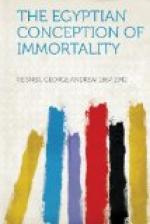During the course of Egyptian history the position in which the body is buried undergoes a series of remarkable changes. During the early pre-dynastic period, the body, loosely enfolded in cloths and skins, is laid in the grave double up on the left side, usually with the head south (i.e. upstream). This position becomes the custom, with very few exceptions, during the late predynastic period and the first three dynasties. Throughout the Fourth to Sixth Dynasties, the body was in the same position, but with the head north, loosely covered with shawls and garments. The crouching position, with some slight modifications, continues to be used for the poorest class down to the New Empire. Among the Nubians, it is universal to the New Empire and customary even later in unmixed Nubian communities. The swathed extended burials begin in Egypt in the Fourth Dynasty, so far as remains are preserved. Some members of the royal family of Cheops were buried in swathed wrapping, lying extended on the left side with the knees bent. During the Fifth and Sixth Dynasties this extended position on the side becomes customary for the better classes; and during the Middle Empire it becomes almost universal.
The final burial position, the swathed mummy lying extended on the back, does not become general until the New Empire, about 1600 B.C. although it is the position hitherto regarded as the characteristic Egyptian burial position. A few isolated cases, some of them perhaps accidental, occur as early as the Old Empire; but in the New Empire the extended burial on the back is practically the only one to be observed. In other words, beginning in the predynastic period with a burial position which may be called natural and primitive, the Egyptian gradually adopted a position which imitated the form of the dead Osiris, the god of the dead. Each new change is first adopted by the royal family, and is taken up by the other classes in turn until it becomes universal. In the final form, the mummy was a simulacrum of the dead as Osiris.
Alongside these changes in the burial position progressed the art of preserving the body. The earliest attempts were made on the body of the king; and the knowledge of embalming gained in preserving his body was gradually utilized for the higher classes and finally for all but the poorest. It seems indisputable that the royal personages of the Fourth and Sixth Dynasties were mummified—i.e., the entrails were drawn, the body prepared with spices and resins and wrapped tightly in cloths smeared with resin. But the mummies of the nobles, even of this period, show no trace of such treatment. The receptacles for the viscera are sometimes found in their graves in the Sixth Dynasty, but are, as a rule, empty, being mere dummy vases. Even in the Middle Empire, the preservation of the bodies of the better classes was extremely imperfect. The bundles of wrappings have kept their form to the present day and it seems as if the mummy were still intact; but an examination of the interior shows only loose bones. Successful mummification appears among better-class people in the New Empire for the first time and becomes a general custom in the Late Period. The processes of successful mummification necessitated the practical destruction of the body.




